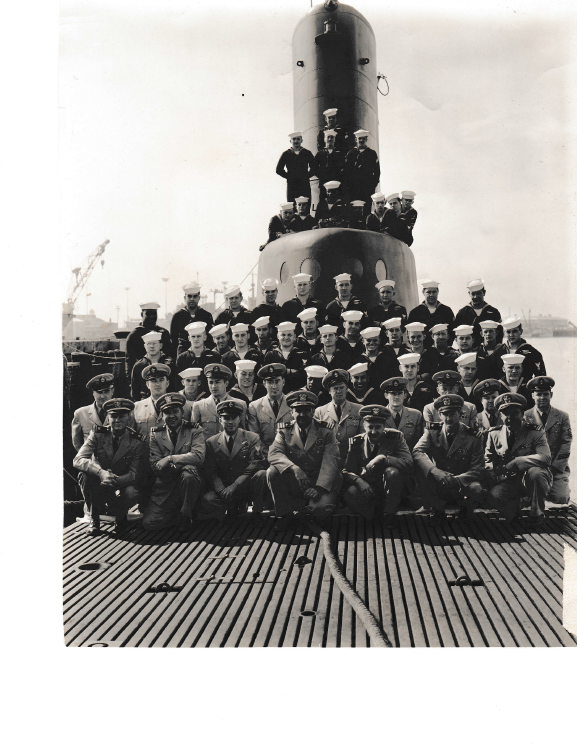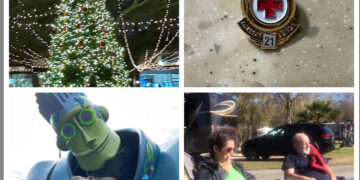
The year 1918 was a difficult one for Edwin and Susan Funk. Their only child, Kingsley died in the flu epidemic. Kingsley was well loved by them, and brought up with privilege. He was handsome, well educated and popular with his peers, and now he was gone. Unknown to the Funks, also in 1918, 175 miles away in Dunbrooke, Va, Paul Golden Saunders was born to a single mother. There was no privilege for them, and Paul became a ward of the Children’s Home Society. In 1926 he was put on a train from Richmond with a letter that read as follows:
This boy, Paul, a ward of the Children’s Home Society is for the home of Mr. & Mrs. Edwin W. Funk, Singers Glen, Rockingham Co., Va. who will meet him at Staunton on the arrival of the train. Respectfully, Wm. J. Maybee, Superintendent
Not long after Paul’s arrival Edwin wrote to the Children’s Home, offering to provide photographs for Paul’s mother. The Home declined, advising Edwin that he should avoid contact with her and her current husband, as they were not suitable people.
Edwin was 52 years old when Paul arrived. He was a man who had lived a life of strong personal discipline. Paul would be raised that way, and he fit in. Paul became popular in his new community, and did well in school. The Funks enjoyed travel, and subscribed to National Geographic, exposing Paul to a larger world. They wanted a fine life for him. A letter from 1933 mentioned Paul’s interest in becoming a doctor, but by the time he turned 17, in 1935, he had focused on a career in the Navy.
There was a problem with the Navy career, however. Paul was still too short at age 18 to meet the minimum height requirement. He had learned that the discs of the spine compress during the day, and a person is taller when they first arise than later in the day. Problem solved – Paul got several friends to take him on a stretcher from his bed directly to the recruiting office where he was measured when he first stood up – he passed, and in 1936 he proudly joined the Navy.
Paul’s first assignment was aboard the light cruiser USS Raleigh as a part of Squadron 40-T doing neutrality patrols during the Spanish civil war. They sailed all over the Mediterranean in that work and Paul sent postcards home from many different ports. He even got to spend a week in Paris where several of his ship mates got married, and he questioned their sanity. By June they were back in Norfolk and he got to visit home, then he was off to duty in the Pacific. Paul was assigned to the destroyer USS Sampson late in 1939, doing training runs for the new ship along the western seaboard. In December of 1939 he was again reassigned, this time to the destroyer USS McCook. It was on old ship, built in 1918 and decommissioned in 1922. With the war in Europe gearing up, even an old ship could be useful and the McCook was re-commissioned. Paul served on her for the time it took to get her to Nova Scotia where she became a British vessel named the St. Croix.
Paul’s assignment following the McCook was the one that made his career – he joined the submarine force. His small stature suited him for that duty. His training on submarines was aboard the sub R-4 based in New London CT. It was an older sub, launched in 1918, and was doing patrols along the east coast and down to Key West, FL. He was still on the R-4 when the Japanese attacked Pearl Harbor. When his training was complete he was assigned to the brand new USS Barb, commissioned on July 8, 1942, where he served for all 12 of the Barb’s war patrols. The first 5 patrols were in the Atlantic under the command of Lt. Commander Everett H. Steinmetz, doing reconnaissance and working against Axis blockade runners. Japan’s capabilities forced the Navy to re-focus their strength to the Pacific, and after a year in the Atlantic the Barb was ordered to New London, CT for re-fitting for service in the Pacific theater.
The Barb changed commanders after re-fitting. Eugene Fluckey took command, and appointed Paul as his chief of the boat (COB), a position Paul held for the remainder of his submarine service. Carl LaVO wrote an article for the March 2011 Naval History Magazine in which he referred to Eugene and Paul as “The Dynamic Duo”, and the Barb as one of the most successful subs sent against Japan. Much of what they did was the hard work of searching out dangerous targets, attacking them with torpedoes, and then working even harder to avoid being destroyed in the response. They did that work well enough to earn numerous medals for it. There were, however, three instances that really made their reputations.
On the Barb’s 11th patrol, on January 23, 1945, the Barb had tracked a fleet of Japanese munitions freighters to Namkwan Harbor. The harbor was 6 miles inside the 10 fathom line, and 25 miles inside the 20 fathom line where subs could submerge to a safe hiding distance. The ships believed it was a safe harbor for them to hide in. The Barb got within 3,000 yards of the fleet running on the surface under cover of darkness. They had to launch their torpedoes from the upper tubes and set the torpedoes to a running depth of only 6 feet to avoid interference from the sea floor. When they began the attack they continued it until they had sunk 5 freighters. The Japanese were stunned – the water was too shallow for submarines, the attack must have been from airplanes. Search lights came on as they scanned the sky. The Barb used the surprise to get a head start for deeper waters, but was soon spotted. The race was on, and the Japanese were gaining. The Barb followed the coast believing that path to be the least likely for an escaping submarine, and a way to throw off their pursuers, but with no luck. They made the decision to tie the engine governors open and run on overload to get a bit more speed, and it was helping. Then they came upon a group of moored Chinese junks in their path. The Japanese radar could not distinguish the sub from a junk, and while the Japanese destroyed the junks, the Barb slipped away to safety. The 5 freighters in the harbor brought the 11th patrol totals to 8 ships sunk, 1 probably sunk (later confirmed) and 4 more damaged. Their success brought a Presidential Unit Citation for all the crew, and a Medal of Honor to Commander Fluckey.
The Barb’s 12th patrol began on June 8, 1945 after a tour back to the US for updates and refitting. The mission of this patrol was to be a distraction to the Japanese in support of operations in a different location. Commander Fluckey traded on the Barb’s excellent reputation to be allowed to patrol along the Japanese mainland, and to have 5” spin-stabilized rockets with a 9.6 pound explosive load and a launcher on the sub – something that had never been done. The rockets were supplied in Hawaii – he requested 100, but there were only 72 on the islands, and he got them all. Their fuses were electrically actuated, and no one knew whether electrical equipment in the sub could inadvertently trip them, so Paul’s crew disassembled them for storage onboard. Their first rocket attack was on June 22, 1945, at the town of Shari, targeting fish canneries and sawmills. They waited until 2:30 AM and came to 4,700 yards from the shore, since the rockets had a limited range. Paul was in charge of the rockets, he got the title “Rocket Captain” and his crew “rocketeers”. They fired 12 rockets at a time, all within 4 seconds. Once again, the Japanese did not suspect a submarine, and turned on searchlights and radar for airplanes while the Barb slipped quietly away. That became the pattern for rocket attacks, and they used up all they had brought. Success varied depending on the targets – factories usually had boilers that blew up with greater force than the rockets. Wooden structures burned, and fires spread through adjacent buildings. The Barb accomplished its mission of distraction, and proved the effectiveness of launching rockets from subs.
The 12th patrol also contained the story most often told about Paul and the crew of the Barb. It was the only landing of US forces on the Japanese home islands during the war. While the Barb was patrolling the coast for rocket targets they found train tracks near the shore. There was a bottleneck area with a single set of tracks, and other areas with multiple lines. If they could blow up the train and its tracks together at the bottleneck they could hinder the war effort for a longer period of time. The crew worked on a plan for several days, and came up with the idea of planting a bomb under the tracks, triggered by a switch tripped when the weight of the train pushed down on the tracks. The only bomb available was the 55 pound scuttling charge for the sub (meant to destroy it rather than allowing it to fall into the hands of the enemy). They had a battery and a switch, and they worked out track deflection under the train’s weight to assure the switch would actuate the bomb. Everyone wanted to be part of the landing party, so they selected 8 men who would go in order to assure an effective mission and still get the sub home if the landing party was lost. They had taken a Japanese prisoner from a ship they sunk, and questioned him about security measures for the train tracks. Their surveillance confirmed his statement that a single man with a dog patrolled the tracks. They took meat to distract the dog if he came. The landing party practiced their roles and learned to be each other’s back-up. They learned to whistle bird calls to communicate in the dark. They waited for an overcast night and the cover of darkness. The time to carry out the plan came just after midnight on July 23. The Barb was 950 yards off the shore when the two rubber boats pushed off. They took 30 minutes to make shore, zig-zagging along because it was too dark to make out markers on land. Bulrushes on the shore made noise as they landed, and a house was only 50 yards away, but they continued undetected. Guards were posted at the boats, a scout was sent to check out a tower down the tracks, and the explosives crew began digging a place for the bomb under the tracks. Their tools made too much noise so they dug with their hands. Their scout came running back saying that the tower contained a sleeping guard. An express train came up so quickly that it got within 80 yards before they spotted it, but they were still undetected. They got the charge set and the switch calibrated and returned to the boats, but the operation had taken longer than expected, and the time for the Barb’s departure was very near. They began rowing, but halfway back heard the sound of an approaching train. They paddled harder, but when the charge went off they had to look back. Parts from the train went everywhere. They made it to the Barb, stowed the boats and crept silently away on battery power only. On shore, lights came on all around, cars and military vehicles came rushing in, but the Barb left undetected. Exactly 2 weeks later Japan had a much larger explosion with the nuclear bombing of Hiroshima.
After the war, Paul continued his career with the Navy, serving on the Barb through 1945, then becoming the first COB of the Cusk from 1946 through 1950, the first sub to launch a guided missile – a JB-2 Loon, derived from the German V-1 flying bomb. From there it was on to the Carbonero as COB through 1957, with similar missile capabilities but longer range controls. He finished his career as COB on the USS Theodore Roosevelt submarine, a nuclear powered sub equipped with 16 Polaris ballistic missiles. He retired from the Navy in 1962, and was quickly recruited by Lockheed Missile and Space Division in California. He also raced cars and got his pilot’s license there. The last time he visited Singers Glen was in the very late 1980’s. He was in a new Cadillac, on his way to Dunellon, Florida to the home where he lived till his death in 2003.
His medals include two silver stars, a bronze star, a medal that is now the Navy commendation medal, a Presidential Unit Citation and a dozen others. In addition, the Navy Submarine League’s professional excellence award is named the Chief Paul Golden Saunders Award.
Credits:
Thunder Below by Admiral Eugene B. Fluckey
The Sailor Who “Torpedoed” a Train By Carl LaVO, Naval History Magazine, March 2011
The folks of Singers Glen who remember Paul, and a pile of old papers I inherited.
































